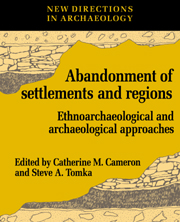Book contents
- Frontmatter
- Contents
- List of figures
- List of tables
- List of contributors
- Acknowledgments
- PART I INTRODUCTION
- PART II REGIONAL ABANDONMENT PROCESSES: ETHNOARCHAEOLOGICAL CASES
- PART III REGIONAL ABANDONMENT PROCESSES: ARCHAEOLOGICAL CASES
- PART IV ABANDONMENT PROCESSES WITHIN SITES: ETHNOARCHAEOLOGICAL CASES
- PART V ABANDONMENT PROCESSES WITHIN SITES: ARCHAEOLOGICAL CASES
- 12 Ceramic analysis as a tool for discovering processes of pueblo abandonment
- 13 Abandonment processes in prehistoric pueblos
- 14 Household abandonment among sedentary Plains societies: behavioral sequences and consequences in the interpretation of the archaeological record
- PART VI CONCLUSIONS
- Index
12 - Ceramic analysis as a tool for discovering processes of pueblo abandonment
Published online by Cambridge University Press: 23 May 2010
- Frontmatter
- Contents
- List of figures
- List of tables
- List of contributors
- Acknowledgments
- PART I INTRODUCTION
- PART II REGIONAL ABANDONMENT PROCESSES: ETHNOARCHAEOLOGICAL CASES
- PART III REGIONAL ABANDONMENT PROCESSES: ARCHAEOLOGICAL CASES
- PART IV ABANDONMENT PROCESSES WITHIN SITES: ETHNOARCHAEOLOGICAL CASES
- PART V ABANDONMENT PROCESSES WITHIN SITES: ARCHAEOLOGICAL CASES
- 12 Ceramic analysis as a tool for discovering processes of pueblo abandonment
- 13 Abandonment processes in prehistoric pueblos
- 14 Household abandonment among sedentary Plains societies: behavioral sequences and consequences in the interpretation of the archaeological record
- PART VI CONCLUSIONS
- Index
Summary
Recent investigations into abandonment processes have relied heavily on ethnoarchaeological studies of abandonment at the household and community levels. Archaeologists have turned toward ethnographic observation as a tool for recognizing behaviors associated with the abandonment of individual houses or entire villages (e.g. Lange and Rydberg 1972; Rothschild et al., this volume; Stevenson 1982). Although the study of abandonment in living societies provides the archaeologist with an array of behavioral possibilities, these accounts must be tested against specific prehistoric cases. In some instances, the events, activities, or behaviors associated with past abandonments may not be repeated by contemporary societies and, therefore, can only be attained through the investigation of archaeological remains. A major problem lies in identifying abandonment processes from material remains that have been subsequently affected by a variety of natural or cultural disturbances.
In order to identify abandonment behaviors, archaeologists need techniques for measuring variability in the prehistoric record. Variability due to natural or cultural disturbances must be distinguished from patterns produced by abandonment behaviors. One technique, the Relative Room Abandonment Measure (Reid 1973), looks at variability in the spatial distribution of ceramic remains at pueblo sites. Two analytical units – whole pots on room floors and sherd density in room fill – are compared to determine the sequence of room abandonment.
- Type
- Chapter
- Information
- The Abandonment of Settlements and RegionsEthnoarchaeological and Archaeological Approaches, pp. 157 - 164Publisher: Cambridge University PressPrint publication year: 1993
- 13
- Cited by



